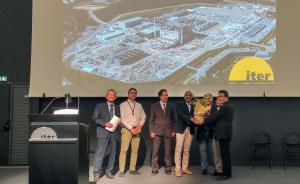ITER celebrates important milestones
On 16 June 2022, the ITER amphitheatre was packed with life again after two years of silence, part of a new project culture initiative called "Commit to Deliver."
The Organization had invited the team that had lifted and safely positioned the first vacuum vessel sector module in the pit last month, and the team representing the cooling water plant, which has been turned over for commissioning. Two important milestones for the ITER project that required a moment of reflection ... and celebration.
In the ITER world, a "module" is an assembly of one vacuum vessel sector, two D-shaped toroidal field coils and corresponding thermal shield panels. When piping, attachments, and lifting gear are added, the total weight of the module reaches 1,380 tonnes—the equivalent of four fully loaded Boeing 747 airplanes.
In May, the first of nine ITER sector modules had "lifted off" during an operation that took more than one year to prepare and plan. The spectacular lift (see this video) tested the limits of the Assembly Hall structure, the lifting capacity of the overhead crane, the complex rigging system, and—perhaps most of all—the coordination of a 50-person team across many different companies and organizations.
ITER's high-performance heat rejection system covers an area of 6,000 m² on the ITER platform and is "a highly visible signal that fusion technology and research has reached the industrial level," as interim ITER Director-General Eisuke Tada said in his address. The system provides a very large capacity: at the peak level—what is called the plasma "burn phase"—the heat load will reach 1145 MW. The water needed to remove this heat load will circulate at the rate of 10 m³ per second.
"These are impressive achievements—both in terms of technical feasibility and multi-organizational collaboration—showing our commitment to deliver," Director-General Tada said before asking the teams to come on stage to receive their awards.
For the past year, the ITER Organization has promoted the importance of a unified team approach, a mindset that is called "Commit to Deliver (C2D)." In recognition of specific team successes, butterfly bushes are planted in a dedicated area near Headquarters. "We hope they will bloom for years into the future, attracting many butterflies, as a reminder of the great work you have all achieved."


